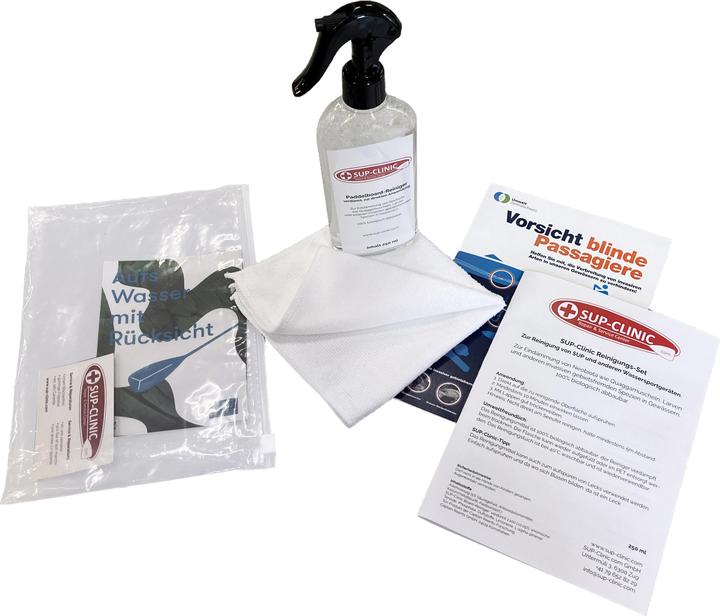

Quagga mussel problem: How to clean your SUP when changing waters
The quagga mussel is spreading in Switzerland. Some cantons therefore recommend cleaning the SUP every time you change waters. The SUP Clinic offers a spray cleaner to make cleaning easier.
If you're out and about on Swiss lakes in a SUP, kayak or rubber boat, you've probably already seen them: the posters drawing attention to invasive species. Followed by the request to check and clean stand-up paddleboards, boats, diving and fishing equipment before every change of water.
Danger from the quagga mussel
The main aim is to prevent the spread of animals and plants that can damage the ecosystem. The quagga mussel is a particular cause for concern: it originally comes from the Black Sea and was introduced to Switzerland around ten years ago.

Since then, it has spread rapidly in lakes and rivers. Lake Constance, Lake Geneva, Lake Neuchâtel, Lake Biel, Lake Murten and Lac de l'Hongrin as well as the Rhine and Aare are particularly affected. However, the danger is not averted with warnings alone: A few months ago, the quagga mussel also appeared in Lake Zurich, Lake Zug and Lake Alpnach, according to the aquatic research institute Eawag.
The invasive quagga mussel can drastically change the ecosystem, eat away the plankton of native species and block water supply pipes. Researchers at Eawag expect the damage to amount to «hundreds of millions of francs», as stated on the info website.
Prevention is the order of the day
Once the mussel is in a lake, it is almost impossible to remove it again, say experts. It is therefore important to stop the spread of mussels and other invasive species in advance.
There is still no standardised regulation in Switzerland, but a number of cantons now stipulate that boats must be cleaned before every change of water and the change must be reported. You can find an overview of the current regulations at the Swiss Sailing Association Swiss Sailing.
For smaller water sports equipment such as SUP, kayaks and diving equipment, the recommendation is to check, clean and dry it.
An easier way to clean
The fact that water sports equipment should be cleaned before a change of water is almost self-explanatory in view of the undesirable species. «But how?» - Kov Balciauskas and Thomas Schillig from the SUP Clinic Switzerland asked themselves. The cantonal recommendations state that SUPs or inflatable boats should be rinsed with clean and, if possible, hot water. However, very few people have hot water with them on a paddle trip.

Kov, who has a Bachelor's degree in Environmental Science and Chemistry and a Master's degree in Coastal Zone Management from the University of Newcastle upon Tyne in the UK, was not satisfied with this solution. «There must be a better way», he said to himself. And began to do some research.
He had already worked on a project in Chicago to contain the zebra mussel, he tells me in conversation. «But the quagga mussel is a much bigger problem.» During his research, he came across studies comparing different purification methods. It was clear to him that a cleaner had to be biodegradable and not damage the SUP board.
He came across an acetic acid-based solution. The acid destroys the lime coating of the mussel larvae. This is not the case with alcoholised disinfectants.
How to use the cleaner
To make cleaning the SUP as easy as possible, SUP Clinic offers the vinegar-based cleaning agent in a spray bottle. Also included is a microfibre cloth and information on invasive species and the most important rules that apply to stand-up paddlers. According to the SUP Clinic, the bottle can be reused or disposed of in PET recycling.

I have already been able to try out the product. The cleaner is easy to spray on. You should keep at least five metres away from the shore. It smells a little sour, but that's to be expected. After ten minutes, it has largely dried and I rub the board with the microfibre cloth (which is washable at 40 degrees, by the way). Positive side effect: even small stains disappear thanks to the treatment.

As I live on a lake that has so far been spared the quagga mussel, I can't judge how effective the cleaning agent is against invasive species. But - as Kov also emphasises in conversation: «It's definitely better to clean the board than to do nothing.»
Research diver, outdoor guide and SUP instructor – I love being in, on and around water. Lakes, rivers and the ocean are my playgrounds. For a change of perspective, I look at the world from above while trail running or flying drones.
Interesting facts about products, behind-the-scenes looks at manufacturers and deep-dives on interesting people.
Show all

